A Rivals Like No Other, Part 1
We have a new set with lots of cool cards. I like telling stories. Seems like a perfect match. So, without further ado, let's start the card-by-card stories of Rivals of Ixalan.
Angrath, the Flame-Chained
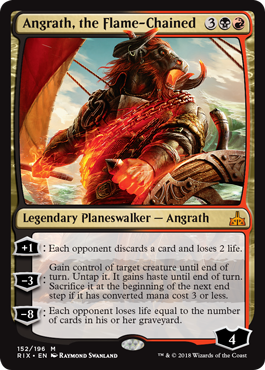
One of the challenges with making planeswalker cards is that we tend to make them based on the needs of the story. What Planeswalkers are in the story? Let's give them cards. Yes, there's some color balancing, as Standard forces us to make sure we spread out the planeswalker goodness into all the colors, but it doesn't tend to force our hand to hit every combination. Case in point: two-color planeswalkers.
When planeswalkers first premiered in Lorwyn, there was a cycle of monocolored planeswalkers. It wasn't until their second appearance, in Shards of Alara, that two-color ones appeared: Ajani Vengeant (red-white) and Sarkhan Vol (red-green). Two-color planeswalkers became a regular feature, but which ones we chose were based much more on story needs than overall planeswalker two-color balance. That meant that some color combinations (I'm looking at you, red-green) got numerous planeswalkers (Arlinn Kord; Domri Rade; Samut, the Tested; Sarkhan Vol; and Xenagos, the Reveler), while others got very few.
The color pair that ended up getting the least love was black-red. For a long time, the only planeswalker to be black-red without any other colors was Sarkhan the Mad, which was just a one-time incarnation of the character. We were constantly being asked for a planeswalker that was just black-red and not a temporary version of another planeswalker. Both Ob Nixilis and Tibalt are black-red in motivation as characters, but for various reasons have always been portrayed on cards as monocolored.
One of the goals we had was to find a time and a place for a black-red planeswalker in a Standard-legal set. (Conspiracy: Take the Crown did manage to make a black-red version of Daretti in Daretti, Ingenious Iconoclast.) We were foiled a bunch of times by other factors. The story and color balancing stopped us from executing on a black-red planeswalker multiple times. Rivals of Ixalan finally allowed us the opportunity, so we wanted to make sure we did it right.
For story purposes, this slot had to be for a Planeswalker from another plane who got trapped on Ixalan. Another request we'd been getting was that a lot of players wanted to see more non-human Planeswalkers. We'd been talking about doing a minotaur Planeswalker for many years, so the stars all seemed to be aligning. The last piece was to design a black-red character, which the story delivered.
Mechanically, a black-red planeswalker wanted to be both aggressive and invasive. It wanted to mess with your opponent's stuff. The trick was to find a way to do that and have all the pieces pull together. Discard seemed like a good fit, as did temporary stealing. Was there a way to create an ultimate that tied those two together? Discard got cards into the opponent's graveyard and stealing could often force chump blocking. What if we keyed off cards in the opponent's graveyard? As we played it, we found that players were avoiding chump blocking because they could see the ultimate. We fixed this by adding the sacrifice rider on the stealing ability. Now you could make sure to get their creatures into their graveyard. We limited the size of what would be sacrificed after being stolen to keep the ability in check and not discourage giant creatures from being played (this is Dinosaur world after all).
And that is how we (finally) ended up with another black-red planeswalker.
Azor, the Lawbringer
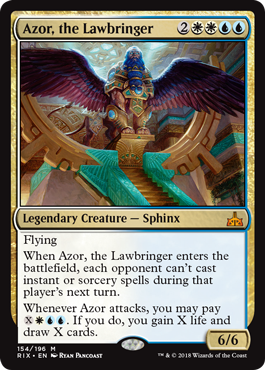
Your reaction to this card has a lot to do with how plugged in you are to the story. If you're not that plugged in, it's a cool Sphinx. If you are plugged in: it's Azor! So who exactly is Azor? For starters, he founded the Azorius guild—it's named after him. He was also the author of the original guildpact and created the Implicit Maze (of Dragon's Maze fame). The audience didn't actually know much about him other than that he wasn't originally from Ravnica, he wasn't currently on Ravnica, and he hadn't been there for some time. It wasn't even known what species he was. It turns out he was trapped on Ixalan. He's involved in the Rivals of Ixalan story and I don't want to spoil any of that, so suffice it to say some things have happened to him, but it was finally time to make him a card.
First off, we wanted it to be impressive. Many Vorthoses have waited years to finally see him on a card, and we didn't want to disappoint. A 6/6 felt about right for size. Second, he's a Sphinx. We've known this for quite a while (even though all of you did not). That meant he had to fly. Third, he needed to be white-blue. Who's more Azorius than Azor? Fourth, he wanted to have some control-ish abilities. That's what the Azorius are known for.
At first blush, these things might seem contradictory. Impressive means large, and large fliers tend to want to attack, not sit around and control things. The secret to this was to give him an attack trigger that resulted in rewards that a control deck would want: life and cards. This also tied nicely into the colors. We added a mana requirement to the trigger, as drawing cards is quite powerful. Then, to add a little bit of extra flavor, we gave Azor a very controlling enters-the-battlefield effect. And voila, we have Azor. I hope he lives up to the expectations.
Azor's Gateway / Sanctum of the Sun
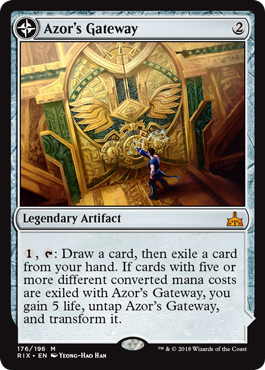
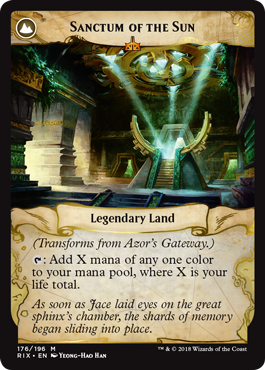
When Ben Hayes and his team started designing Rivals of Ixalan, they knew they were going to create some double-faced cards (DFCs) that transformed into lands. One of the roles of small sets is to continue with popular themes from the large set, and the DFCs definitely fell into that camp. Was there a way to put a spin on them and make them feel like an extension of what Ixalan did, but with their own identity? Rivals of Ixalan is about the four factions fighting over the golden city of Orazca. Maybe the DFCs could help reflect this element? What if the DFCs were symbolic of the quests and challenges that had to be overcome?
Take Azor's Gateway as an example. The factions are all after an artifact known as the Immortal Sun. The Immortal Sun is located in the Sanctum of the Sun, so this card had to represent the final challenge of the story. This meant that the card wanted to be a sweet reward locked behind a troublesome quest. I believe the reward was figured out first. What's a powerful thing a land can do? How about making a lot of mana—and I'm talking a lot of mana, equal to your life total?
Next came the harder part: finding a small enough hoop to make players jump through that was balanced with a land that tapped for so much mana. Also important was the fact that the card needed to have a function while the player was trying to "solve" it. Azor is very wise, so maybe his Gateway would provide you with information. Was there a way to turn that into a quest? The solution came from making it not an artifact that drew cards but rather one that looted (draw and discard). What if you tracked some quality of the discarded cards? (We'd later change it to exile to make tracking the cards easier.) The assumption was, we'd want there to be variety in the items needed, as that didn't force you to build a monolithic deck.
Color greatly limits what kind of deck can play a card. Card type was a possibility. Delirium obviously played in this space recently. We could look at creature types, but that was also tricky. Then there was converted mana cost (CMC). That one was interesting, in that most decks need to have a spread of converted mana costs. Unlike the color restriction, this was one most decks could meet without having to change things all that much. CMC seemed like the best one to try. The final question was how many CMCs to care about. Playtesting showed that five was in the sweet spot—challenging but doable.
Blood Sun
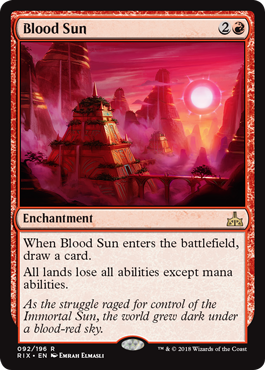
One of the cool parts of making Magic cards is that sometimes you get to not only solve problems but be stylish while doing so. Amonkhet block had added a bunch of lands with abilities to Standard (most blocks do, Amonkhet just added more than average). We wanted to have an answer if those things got out of control. How do you stop what we call "utility lands"? We could destroy them, but the goal was more stopping effects than hurting mana bases.
Okay, what if we just turned them off—the utility part, not the mana part? That would work. What color would do that? White's the color that shuts off abilities of creatures, but white is one of the weaker colors in dealing with lands. (Yes, white can destroy all the lands for a lot of mana, but that's something we do sparingly.) Green is the color that most often interacts with lands, but usually positively. Red has a history of nonbasic land hate. Okay, probably red.
We wanted it to be an ongoing solution, so we liked the idea of the card being an enchantment. Once all the pieces came together, we realized we were making something very similar to this famous Magic card:
Well, if you're going to make a Blood Moon–style card, you might as well lean into it and have some fun. And thus, Blood Sun was born.
Elenda, the Dusk Rose
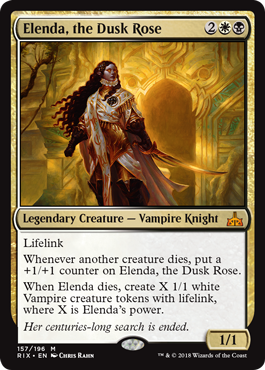
One of the tricks to designing multicolored cards is trying to find abilities of each of the colors that both thematically connect and are mechanically synergistic. Elenda, the Dusk Rose is a wonderful example. What's a black ability that makes a lot of sense on a Vampire? How about what we call the Khabál ability (first seen on the Arabian Nights card Khabál Ghoul), where a creature gets a +1/+1 counter for each other creature that died in a turn? That feels very Vampire-y.
White's a bit trickier. White (and sometimes green) can dip into token creatures, usually smaller ones. If the creature tokens made were Vampires, that would be thematic. Vampire tokens in Ixalan are 1/1 white creatures with lifelink. That plays nicely on a white-black card, as lifelink is the ability white and black share.
The cool thing is that both abilities feel like Vampire abilities and they're synergistic. Every creature death nets you an extra Vampire when Elena dies. And in the meantime, you get a giant lifelink creature that's a big threat, one that is also scary if your opponent kills it. That's something Vorthos and Mel can enjoy.
Etali, Primal Storm
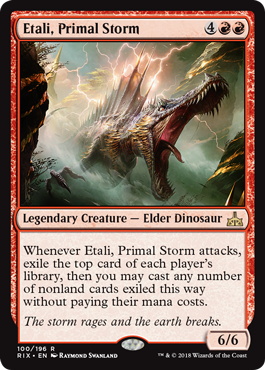
Once we knew we were making a cycle of Elder Dinosaurs, the next step was making sure each one was as splashy as possible. The first place you always go with a red creature is direct damage. It's splashy and useful, but it's a well we draw from a lot. Was there something different we could do? Interestingly, the Council of Colors had just been talking about red.
Red is the color with the deepest mechanics but the narrowest band of mechanics, meaning there are a lot of ways to create traditional red cards, but they feel more similar to one another than other colors. Because of this, we're always talking about what new ability we can give to red. One of the areas of promise was finding new ways to dig into red's sense of chaos. We liked the idea that perhaps red should be doing more spells where you don't quite know the outcome. This, for instance, is what led us to do more Polymorph-style abilities in red.
Card drawing is unknown but a little too consistent for red. That's why we came up with what we call "impulsive drawing," where red exiles cards it then has a turn to cast. Could Etali push in this area? What if in addition to being able to play the card, the spell paid the cost for you? This felt like super-impulsive draw and fit the bill for a splashy red effect.
The Forerunner Cycle

Sometimes new designs are just a combination of old designs mixing and matching things Magic has just never done together. The Forerunner cycle is a good example. First, we take a cycle from Lorwyn known as the Harbinger cycle.
A seldom-seen eight-card cycle, this allowed each of the eight supported creature types in Lorwyn to be able to go and fetch another of the appropriate creature type from your deck. The card went on top of your library to prevent the creatures from being card advantage.
Ben and his team then combined this with what we call trigger lords. A trigger lord is a creature that has a trigger whenever a particular creature type enters the battlefield. It's a way to combine a creature lord with a spell effect. The two effects are synergistic, because you're always setting yourself up to trigger the card on the very next turn. The Forerunners are also nice in that they encourage you to go heavy with the creature type. Rivals of Ixalan was trying to turn up the tribal dial, especially in Limited, and the Forerunners help accomplish this.
The one last thing I wanted to note about this cycle is that it's only four cards. Having four factions requires us to design in a slightly different fashion. Ben and his team made sure that the different four-card cycles didn't leave out the same color.
Form of the Dinosaur
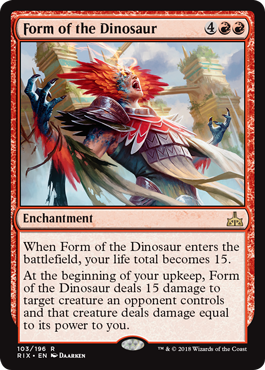
Magic has made over 17,000 cards, but a few are just a bit more memorable than the others. One of the most memorable is Form of the Dragon from Scourge.
Designed by Brian Tinsman, it's a card intended to capture the flavor of turning yourself into a Dragon. It's a weird and quirky card, definitely one bending the color pie more than most, but it's beloved. Other than a parody of it in Unhinged, Form of the Squirrel, we haven't made another Form of the [blank] card. Rivals of Ixalan changes that.
This card entered the file very early and had one simple goal: "You are a Dinosaur." The idea was that you were essentially a 15/15 and every turn you fought with other creatures. During design the big argument was whether this was red or green. Turning into a Dinosaur felt green, but being able to kill multiple creatures without any creature cards on the battlefield was just too much of a color pie violation, so it was decided to put the card into red.
From that point forward, which was super early in the process, very little changed. The card was moved from six mana to seven mana and then was later moved back to six. So now all of you can know the joy of becoming a Dinosaur. Roar!!
The End of Story Time
That's all the time I have for today. As always, I'm eager to hear your feedback on this column, any cards I talked about, or Rivals of Ixalan as a whole. You can email me or contact me through any of my social media accounts (Twitter, Tumblr, Google+, and Instagram).
Join me next week as the stories continue.
Until then, may you do something awesome in a game of Magic.
#498: The Move
#498: The Move
31:44
The entire third floor was recently remodeled, which resulted in R&D being moved to a different section of the floor. This podcast is all about the move and the many pieces of Magic history I discovered while moving.
#499: Lessons Learned: Kaladesh
#499: Lessons Learned: Kaladesh
32:07
This is another in my "Lessons Learned" series where I talk about a design I led (or in this case co-led) and walk through all the lessons I learned from doing it.
- Episode 497 Symbols (21.6 MB)
- Episode 496 Vision Design (20.5 MB)
- Episode 495 Vision, Set, and Play Design (22.1 MB)

